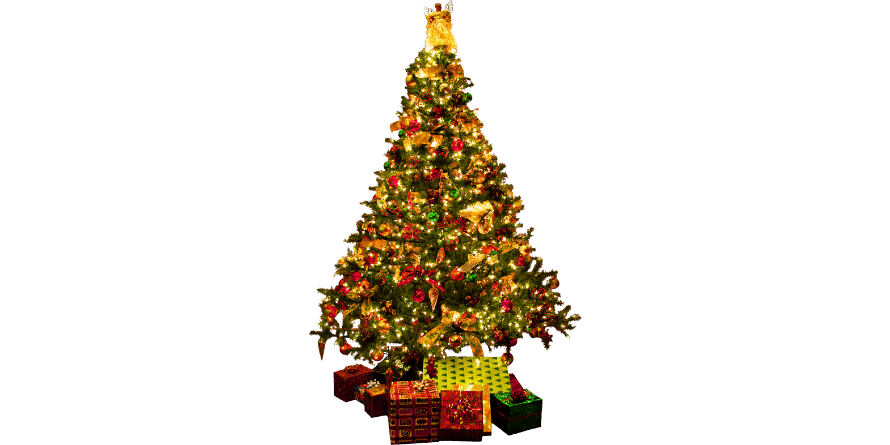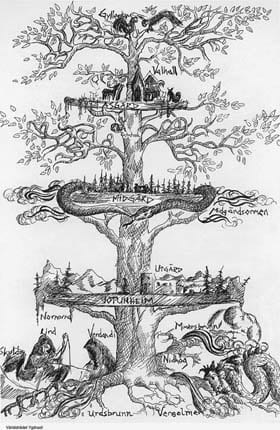
From Japan’s Sakaki trees…to the European Christmas tree: there are countless historical and contemporary examples of humans investing trees with symbolic meaning. (Hellerman 468)
The tree has proven to be a rich source of symbolic meaning across human cultures. With branches that reach skyward and roots that extend below, there is a symmetry and a duality in the tree that lends itself well to meaning making and myth. Perhaps it is this solidity in two worlds that inspired some cultures to envision trees as supportive and connective structures between the realms of their mythologies. Norse peoples saw “the World Tree, a giant ash tree called Yggdrasill” as a kind of bridge between realms (“Yggdrasill”) and the Yucatan Mayas saw the sacred ceiba tree as the means of supporting the sky (Biedermann).
In connecting the spiritual (sky) with the worldly (earth), trees are also seen as being symbolic of the human condition and perhaps nowhere is this clearer than in the use of the tree as a kinship symbol (Russell, “The Tree as a Kinship Symbol”). Like trees, families are old things, with branches and offshoots that extend from a common place. The word “tree” is so interlinked with the idea of the family that we use the term “family tree” as a way to conceptualize our ancestry. Furthermore, the modern Christmas Tree, customarily adorned with a mixture of store-bought and hand-crafted ornaments that often contain the names and images of family members, becomes symbolic of a particular family (Russell, “The Tree as a Kinship Symbol”).
Finally, the last dimension we’ll explore here is the tree as a symbol of knowledge and/or wisdom. Insight customarily follows from great age, and as a result, many peoples associate an old tree with the wisdom of an elder and even treat them with a similar reverence. Harkening back to Norse mythology mentioned at the beginning, it is said that Odin sacrificed himself to himself by hanging in Yggdrasil for nine days and nine nights in order to gain knowledge of the runes (“Odin”).
The tree’s association with knowledge and wisdom can also be found in the musings of thinkers and poets as well as in some of humanity’s more familiar religious stories. For instance, it is said that Siddhartha Guatama’s six-year journey to enlightenment culminated in the seven weeks he spent sitting below the Bo tree (“Buddhism”). And of course, the tree features prominently in Eden, with both the Tree of Life as well as the Tree of Knowledge of Good and Evil, the latter of which ultimately precipitates the Fall (Russell, “The Life Tree and the Death Tree”).
There are many, many more interpretations of the tree left to be explored, and the library provides the means to do it! If you are interested in reading more about symbolism, check out the resources listed below and get in touch with a reference librarian, opens a new window for more information on our reference materials and databases!
Works Cited
Biedermann, Hans. Dictionary of Symbolism: Cultural Icons and the Meanings Behind Them. Translated by James Hulbert, Facts on File, Ltd., 1992.
"Buddhism." World Religions Reference Library, edited by Julie L. Carnagie, et al., vol. 1: Almanac, UXL,
2007, pp. 87-117. Gale eBooks, link.gale.com/apps/doc/CX3448400014/GVRL?u=lln_ptamm&sid=bookmark-GPS&xid=52ca4e1a. Accessed 16 Nov. 2021.
Hellerman, Pauline von. “Tree Symbolism and Conservation in the South Pare Mountains, Tanzania.”
Conservation & Society, vol. 14, no. 4. Ashoka Trust for Research in Ecology and the Environment, 2016, pp. 368-379, https://www.jstor.org/stable/26393259, opens a new window. Accessed 03 Nov. 2021.
"Odin." UXL Encyclopedia of World Mythology, vol. 4, UXL, 2009, pp. 769-773. Gale eBooks, link.gale.com/apps/doc/CX3230900237/GPS?u=lln_ptamm&sid=bookmark-GPS&xid=b79b2565. Accessed 17 Nov. 2021.
Russell, Claire. “The Life Tree and the Death Tree.” Folklore, vol. 92, no. 1. Taylor & Francis, Ltd., 1981, pp. 56-66, https://www.jstor.org/stable/1260252. Accessed 16 Nov. 2021.
Russell, Claire. “The Tree as a Kinship Symbol.” Folklore, vol. 90, no. 2. Taylor & Francis, Ltd., 1979, pp. 217-233, https://www.jstor.org/stable/1259600, opens a new window. Accessed 04 Nov. 2021.
“Tree.” The Continuum Encyclopedia of Symbols. 1994
"Yggdrasill." UXL Encyclopedia of World Mythology, vol. 5, UXL, 2009, pp. 1066-1069. Gale eBooks, link.gale.com/apps/doc/CX3230900323/GPS?u=lln_ptamm&sid=bookmark-GPS&xid=8512f8b3. Accessed 1 Nov. 2021.



Add a comment to: Sign & Symbol: The Tree